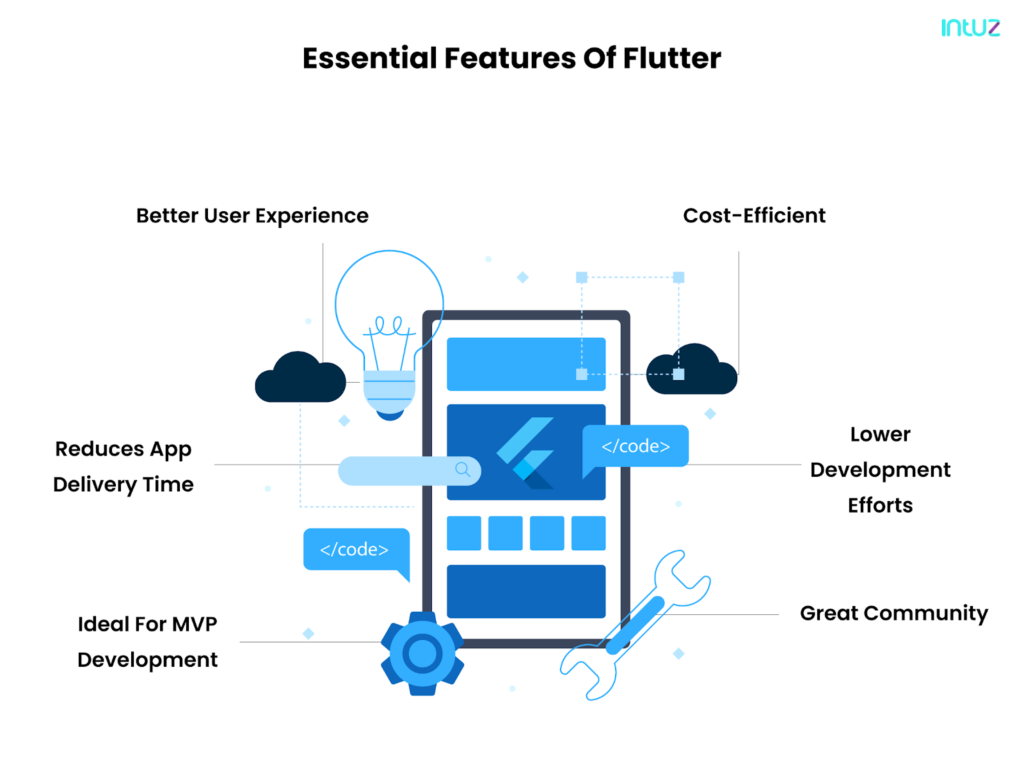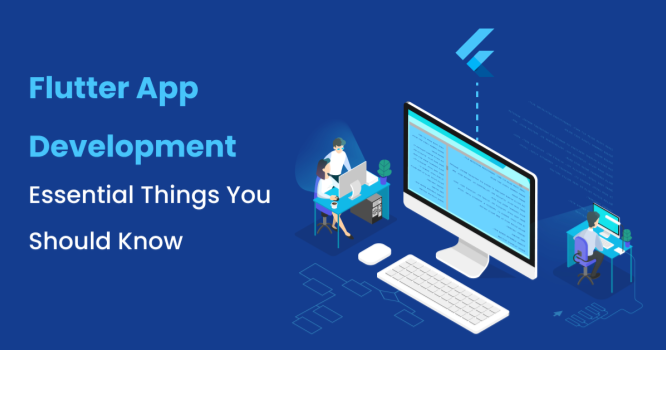Divided by mobile operating systems, companies have to develop their apps twice and roll them out individually for Android and iOS users. This not only doubles the efforts developers and companies have to put in to build an app but double expenses and the time to build the app as well. With time to market dictating profits, initial influx of users, and competitive edge today, companies tend to lose out on a head start with custom application development for Android and iOS devices.
That’s where cross-platform development comes in. With the help of cross-platform development tools, developers and businesses around the world can work on developing an app just once and simultaneously launch them for smartphones across diverse operating systems. Today, we are going to explore one such cross-platform application development framework that goes by the name Flutter and check out its advantages, shortcomings, Flutter real-world examples and more.
So, let’s get started.
What Is Flutter?
Launched in the year 2015 by our very own tech giant – Google, Flutter is an open-source app development framework that allows you to develop cross-platform apps that look, feel and function like native apps. For the uninitiated, cross-platform apps are those that are developed just once with the same code and modified or tweaked slightly when deployed for Android and iOS devices.
Flutter app development comes with a complete ecosystem of widgets and tools, allowing developers to seamlessly build and launch unique apps. One of the standout features of Flutter is that it offers visual and functional consistencies to its apps, making them almost indistinguishable regardless of which operating system you use to access your app.
Also, the ease of development that comes with Flutter is also unparalleled, as it is powered by a programming language called Dart. Initially launched as a rival to JavaScript, Dart offers a minimal learning curve to its developers.
Flutter has been one of the fastest-growing app development frameworks of today that is consistently evolving to accommodate newer requirements and challenges. To throw in some numbers, over 2 million developers use Flutter to develop stable apps and there are over 50,000 apps in the market powered by the framework.
Its superior functionality has quickly made it a fan favourite to become at par with React Native. If you talk to industry experts, you would realize that Flutter is on the race to not just replace React Native but the concept of native app development as well.
So, what are some of the features of Flutter that are making it more prominent by the day? Well, let’s find out.
Essential Features Of Flutter

Reduces App Delivery Time
Flutter reduces your time to market by half when compared to native app development. Thanks to its code once, run anywhere approach, you wouldn’t have to spend time developing distinct apps for iOS and Android devices. This is a fact regardless of the complexity of your app. Compared to other app development tools, Flutter offers an edge to its developers with its unique functionalities. So, developing custom elements and working on complex app modules should not be a concern for development at all. You could keep your deadline stringent and still manage to roll out a stable version as long as you deploy Flutter for app development.
Better User Experience
There’s a difference between a native app and a hybrid app that offers native-like experience to users. The most successful apps are those that don’t make the difference obvious. When users access your app, they shouldn’t be able to distinguish between the experience they would have on a native app and the one they have with your app. With Flutter, this is never the case as the framework is designed to deliver one of the most sophisticated UIs and UXs in the space.
One of the major reasons for this is that Flutter does not depend on code interpretations or intermediate code representations. Apps developed on Flutter are directly compiled to the machine code, removing any chances of interpretation errors in the process. This results in an impeccable user experience.
As far as UI is concerned, developers can make way for polished, interactive and intuitive UI with Flutter, all thanks to Flutter’s widgets and customization abilities. This means you can execute shared transitions, customize shadows, shapes and colors and more without having to put much effort.
Cost-Efficient
Flutter is not just built for functional efficiency but cost efficiency as well. With Flutter, you don’t just eliminate the requirement of two distinct development teams (one for Android and one for iOS), you also minimize the number of individual resources for your app development.
Since Flutter is productive and seamless to work on, the manpower and the man hours required to develop your app are drastically reduced as well. This translates to reduced development expenses. This makes Flutter more cost-effective than its cross-platform counterparts.
Lower Development Efforts
Flutter’s exceptional features like Hot Reload helps developers effortlessly build their applications. Developers usually have a hard time developing UI and incorporating new features and changes because they have to consistently check how their app would feel and function when taken live. With the Hot Reload function, however, the changes are evident almost instantaneously. Besides, fixing changes and bad decisions is also easy. Roll back is as seamless as it gets on Flutter and this stands true even if you decide to reload your entire app.
Great Community
There are certain benchmarks that define the popularity, reach, prominence and workability of flutter app development tools. One such crucial criterion is the presence of a strong developer community. This tells how many developers are actually working on the framework, how active they are, the problems associated with the tool, their fixes and more.
When it comes to Flutter, the community is rock solid. Almost every single hurdle you could possibly encounter when developing your app would have been already addressed and resolved by developers online. This means all you have to do is simply look up official forums, find relevant resources and fix your concerns. The developer community is also open to collaborations for unique projects. The members of the community are collectively making Flutter evolve better and make the framework wholesome.
Ideal For MVP Development
Testing the water before taking a leap into it is crucial and that’s exactly where MVPs come into the picture. For those of you working on unique ideas, alternate solutions to existing ideas and more, developing an MVP will give you an idea on whether the market and your target audience is ready for your solution.
As far as developing an MVP is concerned, the most ideal choice is Flutter. With its ease of developing and the liberty it offers in terms of rolling back changes and adding new features, you could test multiple prototypes of your app in the market easily and still manage to have enough money for full-fledged application development.
Are There Any Shortcomings To Flutter?
No app development tool or framework is airtight and so is Flutter. There are certain shortcomings and loopholes associated with Flutter. While we are objectively discussing Flutter, it makes sense to acknowledge the framework’s weaknesses as well. Let’s check them out individually.
Immature Technology
Flutter is relatively new and consistently evolving. Development challenges are being acknowledged and addressed by founders and community members and it would take a little longer to see Flutter become as matured as React Native. The framework still lacks third-party libraries that makes integrations difficult.
Large Application Size
One thing smartphone users consistently struggle with is storage space. No matter how efficient data management is, smartphones tend to quickly run out of storage space. With respect to this, Flutter hardly seems to help as the apps developed on this platform come with large file sizes (often larger than native apps).
Despite the fact that smartphones of today come with larger storage spaces and access to cloud storage, when every company decides to minimize on budget and roll out cross-platform apps, there would be war to occupy a space on users’ devices. To give you some perspective, a simple app like Hello World could range anywhere between 5 to 7MB when developed using Flutter. With JavaScript, it would be hardly 500KB.
Hard To Find Recruitable Talent
Though we agree that Flutter is immensely easy to use and that it is built for productivity, programmers do have to learn the Dart programming language first. This makes it tough to find recruitable talent in the market and when you decide to upskill your current talent pool to learn Dart, you are only increasing the time required to develop your app. With that said, this is a one-time hurdle and developers usually find Dart easy to learn when they have JavaScript or C background.
Real-world Examples Of Flutter
The world’s second largest retail platform from Alibaba – Xiyanu is powered by Flutter. Developed over a pre-made app, new features were added by Alibaba depending on market requirements and customer behavior. Sources reveal that the app was developed in just two weeks. Flutter complemented the development process with its functionalities. Xiyanu has garnered over 50 million downloads and attracts over 10 million users every single day.
Developed on Flutter, this wholesome app gives information about upcoming Spacex launches, details about the initiative, catalogue of transportation vehicles, insights on capsules, rockets and ships and more. Besides, users could also locate on their devices the location of the Tesla car that was launched into space.
Google Ads for mobile devices was developed on Flutter. Rolling out as a new iteration, this version boasts of a more functional UI, features such as better visualization of charts and images, campaign management, expert support and more.
Wrapping Up
Flutter is rewriting conventions with its functionalities and competencies. Despite a few hiccups, we need to understand that the pros clearly outweigh the cons. What is your take on Flutter? Would you deploy Flutter to develop your app?


